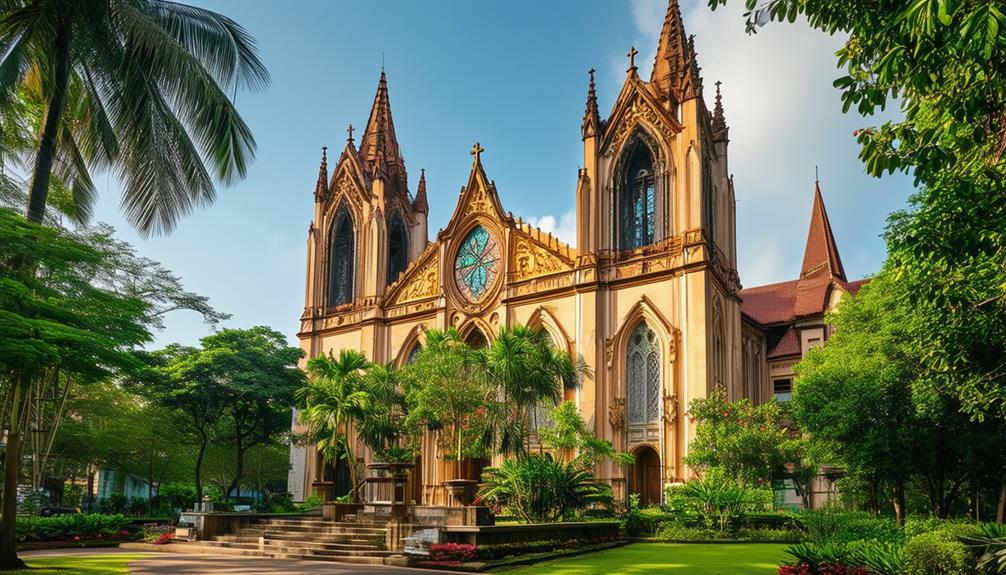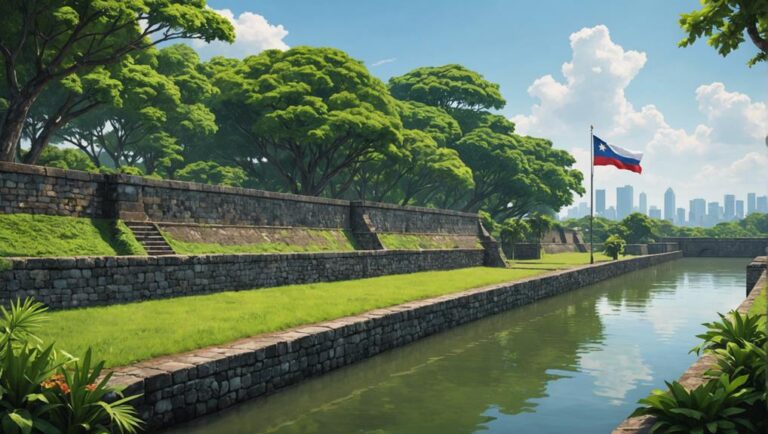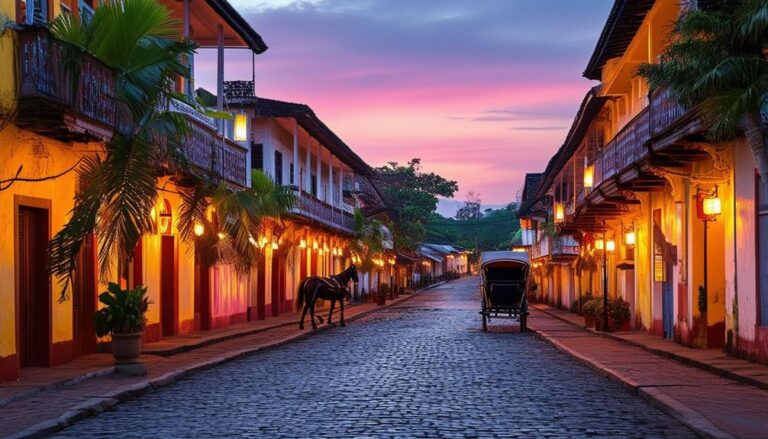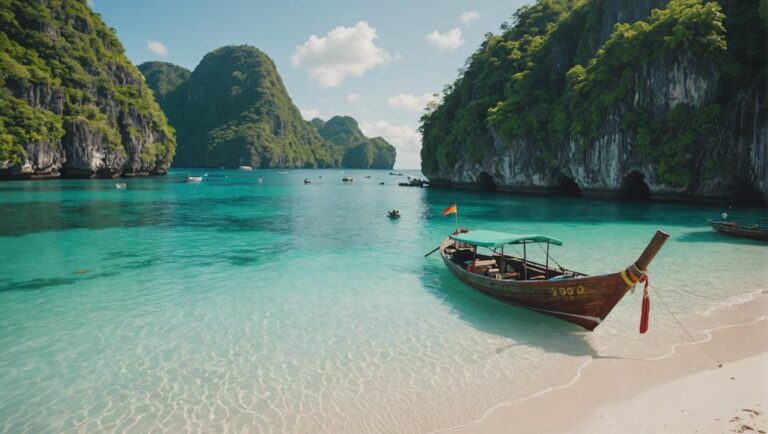Step Back in Time: Exploring the Majestic San Sebastian Church in Manila

Stepping into San Sebastian Church in Manila feels like a journey through time, immersing you in its breathtaking Gothic architecture and rich history. Completed in 1891, this all-steel marvel boasts a stunning light blue facade and intricate spires that reach towards the sky.
Inside, light filters through stained glass windows from Germany, casting colourful patterns on the floor. As you wander, the peaceful ambiance invites quiet contemplation. Accessible via the bustling streets of Quiapo, it’s both a spiritual retreat and a photographer’s dream.
Discover the stories, the resilience, and the artistry that make San Sebastian a true Manila gem. More awaits you beyond these walls.
Highlights
- San Sebastian Church, completed in 1891, is Asia’s only all-steel church with Gothic-inspired architecture.
- The church features stunning stained glass windows from Germany that enhance its serene interior ambiance.
- Located in Quiapo, the church is easily accessible via LRT Line 1 and jeepneys.
- Active restoration efforts ensure the preservation of its unique Gothic Revival features.
- The church hosts daily masses, spiritual events, and the annual Feast of Our Lady of Mount Carmel.
Overview of San Sebastian Church
San Sebastian Church, officially known as Basilica Minore de San Sebastian, stands as a unique architectural marvel situated in Quiapo, Manila. Recognized for its distinctive Gothic architecture, San Sebastian Church holds the prestigious title of being Asia’s only all-steel church.
Its light blue façade, adorned with towering spires, immediately captures the eye, inviting visitors to explore its historic beauty. Completed in 1891, this National Historical Landmark boasts an equally impressive interior, featuring steel columns, groined vaults, and intricate brown shades that add depth and character to the space.
Walking through San Sebastian Church, one can’t help but marvel at the stained glass windows imported from Germany, which cast colorful patterns of light across the interior. The murals depicting saints, alongside the Gothic elements in the pulpits, altar, and retablos, showcase the church’s rich artistic and architectural heritage.
Declared a National Historical Landmark in 1973, San Sebastian Church symbolizes resilience and heritage amidst the bustling urban landscape of Manila. Its remarkable blend of history and artistry makes it a must-visit for anyone interested in the cultural and architectural legacy of the Philippines.
Architectural Significance
How does one encapsulate the architectural significance of Basilica Minore de San Sebastian? This steel church, standing proudly in Manila, is Asia’s only all-steel church, completed in 1891.
The use of prefabricated steel components sourced from Belgium was an architectural marvel at the time, showcasing innovative construction techniques that were ahead of their era. The stunning Gothic-inspired architecture, with its intricate spires and detailed facades, makes it a true gem in the heart of the city.
The church’s stained glass windows, imported from Germany, add an enchanting layer of beauty, casting colorful light across the interior. These windows, combined with the intricate murals depicting saints and other Gothic elements, create a mesmerizing blend of European design and local cultural influences.
The artistic value of these features cannot be overstated; they contribute greatly to the church’s overall aesthetic appeal.
Moreover, the design is thought to be influenced by Gustave Eiffel, the mastermind behind the iconic Eiffel Tower, which further underscores its architectural significance.
Historical Context
The historical context of Basilica Minore de San Sebastian is deeply intertwined with the rich fabric of Manila’s colonial past. Originally constructed in 1621 by the Augustinian Recollects, San Sebastian stands as one of Manila’s oldest religious sites. The church has witnessed a myriad of historical events, including a devastating fire during the Chinese Filipino uprising. This tragic event necessitated the rebuilding of the structure in its current form, completed in 1891.
San Sebastian’s history is a reflection of resilience and cultural heritage. The church’s Gothic Revival architecture, with prefabricated steel components sourced from Belgium and stained glass windows from Germany, reflects a unique blend of European design and local elements.
A stroll through this National Treasure proclaimed in 2011, reveals the oldest image of Our Lady of Mount Carmel, an emblem of devotion and faith.
Unique Steel Structure
Amidst the bustling cityscape of Manila, the Basilica Minore de San Sebastian stands out as a tribute to architectural innovation and historical resilience. This remarkable church, completed in 1891, is the only all-steel church in Asia, showcasing a unique steel structure that continues to amaze visitors.
| Feature | Description |
|---|---|
| Construction Year | 1891 |
| Material | Prefabricated steel components |
| Architectural Style | Gothic influences |
| Source of Steel | Belgium |
| Historical Recognition | National Historical Landmark |
The San Sebastian Church’s design is a marvel of Gothic architecture, with its soaring spires and intricate steelwork. Walking up to the church, it’s hard not to be captivated by the way the steel structure glistens under the Manila sun. The steel components were prefabricated in Belgium, shipped to the Philippines, and then meticulously assembled on-site. This innovative approach not only sped up construction but also guaranteed remarkable durability.
Inside, the church feels almost ethereal. The steel beams, though strong and industrial, don’t take away from the warmth and serenity that envelop you as you step in.
Stained Glass Windows
A tribute to artistic brilliance, the stained glass windows of San Sebastian Church elevate its architectural grandeur. These intricate pieces were imported from Germany, serving as both a demonstration of fine craftsmanship and a focal point of the basilica’s majestic structure.
- Depicting various saints and religious scenes, the windows add a rich fabric of color and history to the Gothic aesthetic of the church.
- Walking into San Sebastian, one immediately notices how the stained glass windows filter natural light, casting beautiful patterns that dance across the church’s interior. This serene atmosphere envelops visitors, making it a perfect spot for reflection and appreciation of the church’s rich history.
- The vibrant colors and detailed designs bring each scene to life, inviting one to pause and take in the artistry.
- An integral part of the church’s architectural significance, these windows reflect the craftsmanship and artistry of the late 19th century.
- Preserving these stained glass windows is essential; ongoing restoration efforts guarantee that future generations can continue to marvel at their beauty.
Accessibility and Directions
For visitors planning a trip to San Sebastian Church, accessibility is a significant advantage. Located in the heart of Quiapo, the church is well-connected by various public utility vehicles, making it easy to reach for both locals and tourists.
If you’re taking the LRT Line 1, you have two convenient options. First, you can alight at Doroteo Jose station. From there, hop on a jeepney heading to Sta. Mesa for a short ride, followed by a brief walk to the church.
Alternatively, you can get off at the Central station and catch a jeepney marked “San Miguel-Quiapo,” which drops you directly in front of the church. Clear signage and helpful locals make navigation straightforward, even for first-time visitors.
The surrounding area of Quiapo Church is bustling with activity, adding to the adventure. As you navigate through the vibrant streets, you might catch the aroma of street food or the sound of vendors calling out to passersby.
This accessibility and straightforward directions make visiting San Sebastian Church a hassle-free and enjoyable experience, ensuring that you can focus on the historical and architectural splendor awaiting you.
Visitor Experience
Upon arriving at San Sebastian Church, visitors are immediately struck by the basilica’s breathtaking Gothic-inspired architecture, characterized by its light blue façade and towering spires. This architectural gem stands as a unique landmark in the history of Manila, inviting guests to engage themselves in its calm and majestic atmosphere.
Inside the basilica, the experience is equally enchanting. Intricate stained glass windows and murals depicting saints adorn the interior, creating a peaceful environment perfect for reflection and admiration of art. The interplay of light through the stained glass adds a mesmerizing quality, making every visit feel like stepping into a living painting.
For those keen to explore deeper into the history and architecture of San Sebastian, educational opportunities abound. Guided tours and informational plaques provide insights into the basilica’s Gothic design and historical significance, enriching the overall visitor experience.
To keep you interested, consider these highlights:
- Photography Enthusiast’s Dream: Capture the stunning architecture and detailed artistry.
- Calm Reflection: Enjoy the peaceful ambiance ideal for quiet contemplation.
- Historical Learning: Discover the rich history of Manila through the lens of this iconic basilica.
Religious Services and Events
While San Sebastian Church stands as an architectural marvel, its role as a vibrant spiritual hub is equally compelling. This historic basilica hosts a variety of religious services, including daily masses and special liturgical celebrations, forming the heartbeat of the local community. Weddings here are particularly enchanting, filling the air with a palpable sense of joy and tradition.
One of the most significant events at the church is the Feast of Our Lady of Mount Carmel. This celebration attracts large crowds of devotees who gather to honor the Virgin Mary through processions, prayers, and communal feasts. The church’s atmosphere during this time is electric, brimming with devotion and a deep sense of community spirit.
Throughout the year, the church also organizes novenas, prayer services, and spiritual retreats. These events foster a strong sense of community among parishioners, allowing them to deepen their faith and connect with one another.
Additionally, San Sebastian Church serves as a venue for cultural events, blending religious observances with artistic performances that celebrate Filipino heritage.
Preservation Efforts
San Sebastian Basilica’s preservation efforts are a demonstration of the dedication of both local and international experts committed to maintaining its original Gothic Revival splendor. The Basilica is undergoing active restoration and conservation projects, adhering to international standards to guarantee its historic features remain intact.
A specialized technical team of local and foreign professionals is addressing critical restoration needs, particularly focusing on the Basilica’s dome as of 2021.
To support these efforts, the Save San Sebastian Basilica Foundation has initiated creative fundraising campaigns. These include selling unique merchandise like art prints and coasters, which not only raise funds but also spread awareness about the Basilica’s cultural significance.
Engaging the community through campaigns like #SaveSanSebastian emphasizes the importance of collective action in preserving this architectural gem.
- Community Campaigns: Initiatives like #SaveSanSebastian encourage public involvement.
- Fundraising Merchandise: Creative items such as art prints and coasters support restoration.
- Educational Programs: These programs raise awareness about the Basilica’s historical value.
Cultural Impact
The extensive preservation efforts underscore the Basilica’s significance beyond its architectural splendor, highlighting its profound cultural impact on the community.
The Basilica Menor de San Sebastian is not just an example of European Gothic architecture meeting local religious traditions; it has woven itself deeply into the cultural fabric of Manila. As the only all-steel church in Asia, it stands as a demonstration of human ingenuity and resilience, drawing in both local and international visitors who marvel at its unique structure.
Declared a National Historical Landmark in 1973, the church plays an essential role in preserving Filipino heritage and history. This designation fosters a sense of identity among locals, who take pride in the Basilica’s rich history.
The annual Feast of Our Lady of Mount Carmel is a significant event held at the church, connecting the community through shared cultural practices and religious devotion. Current restoration efforts are a demonstration of the community’s commitment to cultural preservation.
These initiatives encourage public involvement and awareness, ensuring that the Basilica Menor de San Sebastian remains a living monument to the city’s vibrant past, present, and future. It’s a place where history, faith, and community spirit coexist harmoniously.
Additionally, guided tours of Old Manila often include transportation to the church, making it more accessible for visitors to experience its historical and cultural significance firsthand.






